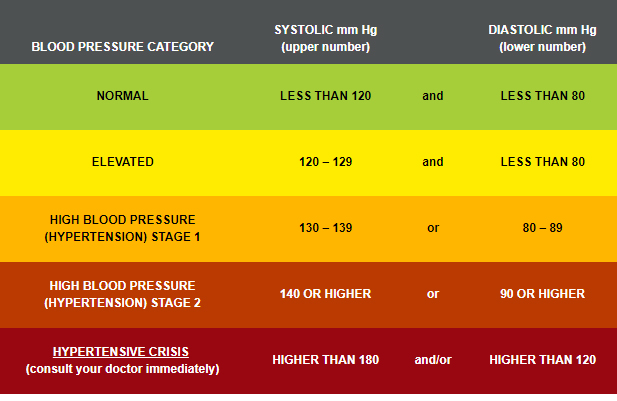You’ve probably read in the news that the American Heart Association has recently published new guidelines for blood pressure. We will go over the changes in a minute, but let’s chat a little bit about blood pressure in general.
What is blood pressure?
Blood pressure is the pressure of the blood against the walls of the arteries. The first (systolic) number represents the pressure while the heart contracts to pump blood to the body. The second (diastolic) number represents the pressure when the heart relaxes between beats. High blood pressure increases the risk of heart disease and stroke and is known to be a ‘silent killer’ because high blood pressure has no signs or symptoms. This is why screening is important. In 2010, hypertension was the leading cause of death worldwide. Any blood pressure above normal should be discussed with your primary care provider.
So what are the new guidelines for blood pressure?
Under the old guidelines, a blood pressure of 120-139/80-89 would be pre-hypertensive, 140-159/90-99 would be Stage 1 Hypertension, and 160 or higher/90 of higher would be Stage 2 Hypertension. The updated guidelines are as follows:

Here are the highlights from the American Heart Association:
· High blood pressure is now defined as readings of 130 mm Hg and higher for the systolic blood pressure measurement, or readings of 80 and higher for the diastolic measurement. That is a change from the old definition of 140/90 and higher, reflecting complications that can occur at those lower numbers.
· In the first update to comprehensive U.S. guidelines on blood pressure detection and treatment since 2003, the category of prehypertension is eliminated.
· While about 14 percent more people will be diagnosed with high blood pressure and counseled about lifestyle changes, there will only be a small increase in those who will be prescribed medication.
· By lowering the definition of high blood pressure, the guidelines recommend earlier intervention to prevent further increases in blood pressure and the complications of hypertension.
What can you do if you have high blood pressure?
While it’s not easy, there are 4 main things you can do to help control high blood pressure: lose weight if needed, get active, limit alcohol, and stop smoking.
Despite what some may think, the changes were not done to force more people to go on blood pressure medication and the numbers were not pulled out of thin air. The American Heart Association stated that “The new guidelines were developed by the American Heart Association, American College of Cardiology and nine other health professional organizations. They were written by a panel of 21 scientists and health experts who reviewed more than 900 published studies.” In other words, they did their homework.
Click here for the full press release from the American Heart Association.
What do you think of the new changes? Will you change your habits to try to meet the new guidelines? Or are you already with the recommended ranges because of a healthy lifestyle?